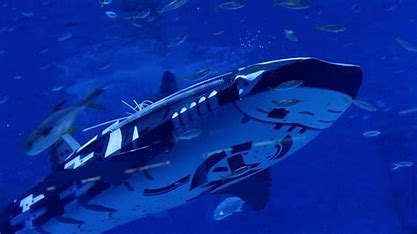
A Shenyang-based company has achieved a remarkable breakthrough in marine technology by creating the world’s first intelligent robotic whale shark. Developed by Shenyang Aerospace Xinguang Group, under the Third Academy of China Aerospace Science and Industry Corporation Limited, this advanced bionic robot represents a significant leap forward in underwater exploration.
A Bionic Marvel
The nearly five-meter-long, 350-kilogram robotic whale shark is designed to replicate the movements of a real whale shark with astonishing precision. It can swim, turn, float, dive, and even mimic mouth movements just like its natural counterpart.
“This is the largest bionic fish we have developed to date,” said Gao Chao, designer at Shenyang Aerospace Xinguang Group’s Underwater Propulsion Technology Research Office. “The whale shark has seven actuated joints, each requiring complex computing, communication, and sensing—a key technology of ours.”
Advanced Functionalities
The robotic whale shark is equipped with state-of-the-art features, including wireless remote control, programmed swimming, and multi-joint bionic propulsion. It can reach speeds of up to 0.7 meters per second and dive to depths of 20 meters. The robot is also outfitted with optical cameras, various sensors, sonar, and BeiDou positioning systems, making it ideal for tasks such as water quality monitoring, underwater terrain mapping, and specialized missions.
Fang Xuelin, assistant director of the Underwater Propulsion Technology Research Office, highlighted the robot’s advanced capabilities: “When performing underwater tasks, the robot will encounter various obstacles. It must process data from multiple sensors to identify the surrounding environment effectively, similar to how a whale shark’s brain operates.”
Environmental and Technological Advantages
Compared to traditional propeller-driven underwater robots, the bionic whale shark offers several distinct advantages. Its enclosed design prevents water pollution, while its streamlined body minimizes the risk of entanglement with aquatic obstacles, reducing harm to marine life. This innovation sets a new standard for environmentally conscious underwater robotics.
Expanding the Bionic Product Line
Building on the success of the whale shark, Shenyang Aerospace Xinguang Group has expanded its bionic product line to include models of Yangtze finless porpoises, killer whales, and dolphins. By seamlessly integrating marine bionic technology with intelligent systems, the company is at the forefront of innovation in the underwater robotics sector.
The Future of Marine Exploration
As humanity continues to explore the depths of the oceans, underwater robots like the intelligent whale shark are becoming essential tools for research and development. With advancements in materials science, control systems, and artificial intelligence, these bionic robots are set to revolutionize marine operations and scientific research, paving the way for a new era of ocean exploration.















